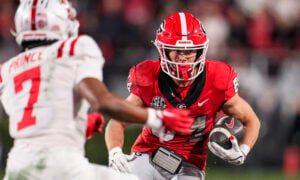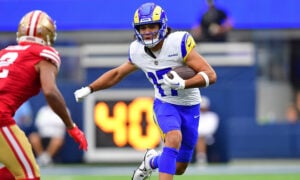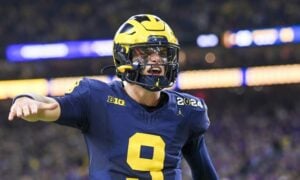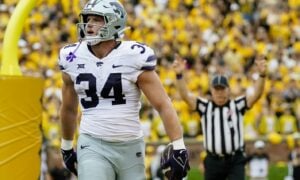Dynasty Purgatory: DeVante Parker
As I haven’t put forward a new chapter in almost four years, it’s fair to wonder if, in the height of irony, the only thing in purgatory all this time was this series? Indeed, lying dormant since an exposé on newly signed Minnesota receiver Greg Jennings (talk about a trip down memory lane!), the cobwebs here are big enough to trap a hobbit on his way to Mordor to destroy a ring. To that I say, out with the old (literally – four of my previous six pieces featured guys who are now out of the league, including Jennings, Maurice Jones-Drew, Wes Welker and Santonio Holmes) and in with the new!
While I’ll still feature aging players who were either coming off a down year, or facing a career crossroads of sorts, I also want to include a fresh focus on dynasty’s shiny toys. And who better to start with than the rare dynasty unicorn, a young former first round pick who improved his numbers from year one to year two and actually lost value. I’m talking about Dolphins wide receiver DeVante Parker.
Shall we begin?
The Essentials
Age: 24
Team: Miami Dolphins
Years in the League: Two
Statistics to Date
[am4show have=’g1;’ guest_error=’sub_message’ user_error=’sub_message’ ]
| Year | Targets | Receptions | Yards | TDs | YPR | YPT | First Downs | PPR Points | PPR Finish | AIR | FDR |
|---|---|---|---|---|---|---|---|---|---|---|---|
| 2015 | 51 | 26 | 494 | 3 | 19.0 | 9.7 | 20 | 93.4 | WR78 | 1.15 | 1.18 |
| 2016 | 90 | 56 | 744 | 4 | 13.3 | 8.3 | 34 | 154.4 | WR50 | 0.96 | 1.08 |
Looking at the raw numbers, it’s easy to see that on the aggregate, Parker showed improvement from his rookie season. He accrued 39 more targets, turning them into an additional 30 receptions for 250 more yards, 14 more first downs, and an extra score. With that said, his efficiency dipped rather dramatically, as the sophomore lost 5.7 YPR and 1.4 YPT off of his 2015 totals.
This showed up in his Adjusted Improvement Ratio (AIR) metric, where he went from a well-above average 1.15 rookie score to a below average value of 0.96. It’s here, however, that I’d like to point out the weighting factor that touchdowns add to the equation, and more specifically, when said touchdowns can be scored on a lesser number of targets. To that point, the trio of Kenny Stills, Dion Sims, and Damien Williams accounted for 16 of Miami’s 27 passing scores (59.3%) on only 147 of the team’s 477 targets (30.8%) – that’s a game changer for the AIR metric, and helps explain (while not completely mitigating) Parker’s score.
Continuing, though Parker achieved a lower First Down Ratio (FDR) as well, he still converted such plays at a better-than-expected clip (1.08). I like the FDR metric because it shows me when players are good at “real life football,” and while that won’t always produce a linear pathway to fantasy stardom, it certainly doesn’t hurt. The fact Parker was doing his job in an NFL sense helps allay the fears stemming from a poor AIR score.
ADP Tracking
Let’s take a look at Parker’s ADP progression dating back to January of 2016, using DLF’s handy dandy ADP Comparison Tool:

As can be construed from the above, owners were anticipating a 2016 breakout, valuing Parker as a late second round startup draft pick over the winter months. This was likely aided by the departure of Rishard Matthews to Tennessee, though Parker’s value did seemingly drop a small bit with the drafting of Leonte Carroo. When the games began and the bullets started flying, Parker fell even further, only reclaiming value at the conclusion of Miami’s brief post-season run. The re-signing of Stills threw yet another wrench into Parker’s value, and he’s been sliding ever since, currently residing as a fifth round startup pick.
Trade Value
Once again, let’s use another DLF toy, the Dynasty Trade Finder, in order to ascertain Parker’s most recent worth. To do so, I isolated trades from May 2017 onward, and drilled down to a PPR, 1QB, 4-point pass TD setting. The trades are summarized in the table below, and I’ve color coded them to describe, in my subjectively objective opinion (largely based off of the ADP of the component players), whether Parker returned proper value. Green means Parker was valued above his price, yellow means he was valued in accordance with his ADP, and red means Parker didn’t return enough value.

Of the 18 trades, I identified nine (50%) where Parker didn’t return much in the way of value. The lowlights include being valued as a second (and third!) round pick, as well as being a bit player in larger deals. All told, it’s fair to reason his trade value is lagging behind his ADP.
Reasons to Keep the Faith
1. Stay Puffed – I defy you to find a better recipient for the 2017 Off-Season Puff Piece All-Star Award. Don’t believe me? Just consider the last four Rotoworld headline blurbs:
- “DeVante Parker set for ‘giant’ third-year leap?”
- “Coaches think DeVante Parker can ‘dominate’”
- “DeVante Parker expects to have ‘big season’”
- “Miami hoping for ‘gigantic year’ from DeVante”
Does this actually mean anything? In short, no, but it’s much better than the alternative. Parker having the trust of the coaching staff can go a long way towards fulfilling his promise.
2. College Dominator – It would be imprudent to forget just how good Parker was at Louisville. It doesn’t show up in the raw numbers, but Parker led the team in both yards and receiving scores for three years straight, starting as a sophomore. Over that time he actually accounted for 33.3% of the team’s receiving touchdowns, and all this was despite the fact he only played in six games his senior season (his weekly line stood at 7.2-143-0.8 in his final year). Circling back to his 2016 AIR score above, at the minimum this provides hope he can turn his lack of goal-line prowess around.
3. Improving Baseline – While Parker was far from special as a sophomore, he definitively showed incremental improvement. To wit, upon factoring out those who didn’t play in at least ten games, the PPR PPG line for functioning as a weekly WR3 in 2016 stood at 12.2. Despite a less prolific offense (more on that below), Parker was able to best that total in six of 15 games (40%). Again, this is far from special, but it’s important to note nonetheless.
Reasons to Jump Ship
1. You’re Stills the One – In what was one of the more surprising moves of the off-season, the Dolphins re-signed Kenny Stills to a four-year, $32 million contract with $20 million guaranteed. While this is certainly worrisome, as there will be more mouths to feed, it could just as well be an indictment on rising second-year player Carroo, who is rumored to not even have a roster spot locked down. With that said, it’s impossible to construe this as positive news.
2. Ground and Pound – From the season prior, the Dolphins decidedly took the air out of the ball. They lost 111 passing attempts, 49 receptions, and 515 yards from their 2015 tallies (though they somehow managed to produce an additional three passing scores). Part of this is certainly due to quarterback Ryan Tannehill’s injury forcing 87 attempts from backup Matt Moore, but the fact remains the Dolphins ran the ball 61 more times and increased their win total from six to ten. If it ain’t broke, don’t fix it.
3. JT(D) – Supplementing the Stills contract was an off-season trade for tight end Julius Thomas. If there’s one thing Thomas does well, it’s get hurt and miss time. However, when he’s actually on the field he does a second thing at a pretty decent clip, which is score touchdowns. I’ve already spoke to Parker’s scoring woes above, and adding Thomas to the fold certainly dings the optimism for a turnaround.
In Conclusion
I’m old enough to remember when the third-year wide receiver breakout was a thing. And then 2014 happened and ruined our collective expectations for when a player should become good. Of course, this obscures the fact that since then, Year One relevance has been few and far between (only Amari Cooper, Stefon Diggs, and Tyreek Hill come to mind).
So in summation we have a young, ascending player who excelled in college and has significant draft capital on his side. He improved from his rookie season, but now faces potentially even more competition for relevance. His coaches seem to be in his corner, but at the moment that amounts to nothing more than off-season puffery.
So, what should we do?
At the price of the dynasty WR33, I’m holding, or buying. When I look at some of the players immediately below him (Martavis Bryant, Randall Cobb, Jordan Matthews, Randall Cobb, Sterling Shepard, Kevin White, etc.), I see just as many, if not more question marks, and less in the way of upside. Ultimately, I expect Parker to increase his 2016 target share of 18.9% to more in the range of 22-25%, and given his steady improvement that could yield WR3 numbers as soon as 2017. If and when that happens, his value will likely bounce back, at which point you could either keep riding the lightning, or trade him and potentially turn a profit. I’m willing to bet on that likelihood, and anticipate dynasty owners remembering exactly why he was so highly thought of in the first place.
Follow me on Twitter @EDH_27
[/am4show]


































































